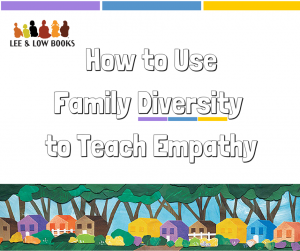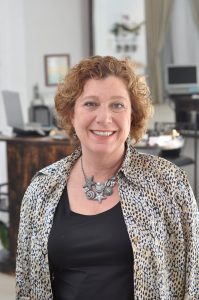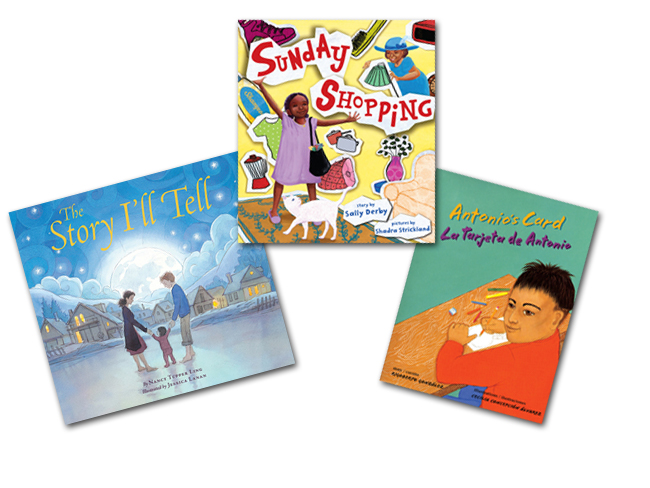![]() In this interview with The Open Book, guest blogger Dr. Becki Cohn-Vargas, Director of Not in Our School, shares the organization’s latest video release about families and family structures. Not in Our School is part of the larger organization of Not in Our Town and focuses on empowering students to create safe, inclusive, and empathetic communities.
In this interview with The Open Book, guest blogger Dr. Becki Cohn-Vargas, Director of Not in Our School, shares the organization’s latest video release about families and family structures. Not in Our School is part of the larger organization of Not in Our Town and focuses on empowering students to create safe, inclusive, and empathetic communities.
“We are more alike, my friends, than we are unalike.” —from “Human Family” by Maya Angelou (listen to Maya Angelou read the poem here)
At Not In Our Town, we are extremely pleased to be sharing our film, “Our Family,” with the Lee & Low Open Book Blog community. Our hope is for our film to become part of the growing collection of resources that educators are using to create identity safe classrooms where children of all backgrounds feel a sense of belonging. These classrooms should not be colorblind spaces, where differences are ignored or where students must leave their identities, stories, and experiences at the door. It is our belief that belonging is created through drawing on the diversity in every classroom as a resource for learning. And quickly, we learn that, as Maya Angelou so aptly pointed out, we are more alike than different.
LEE & LOW: What inspired you and your team to create this video focusing on family configuration and family diversity? Put another way: Why create a film about family configuration and diversity from an organization that fights prejudice, bullying, and discrimination?
Part of fostering a sense of belonging for children is creating an environment where they feel fully accepted for who they are. Even from a young age, children are aware of and have many aspects that make up their social identities. That includes: how they look, the language(s) they speak and the way they express themselves, as well as their culture, religion, race, and gender identity. Their families, a huge part of their lives, form a crucial part of their identities.
Children need to see themselves reflected in the curriculum, on the walls, and throughout their school life. They need to see others like them and they need to learn to appreciate those who are not like them. That does not always happen. My daughter announced at age four that she wanted a sex change operation to become a boy. At that time, we had no idea where she heard about this (she is now 33) because nobody was talking about transgender issues and back then. She did get strange reactions at preschool when she told people she was a boy. I remember she loved doing Mexican dancing, but when they insisted she wear the girl’s outfit, that was the end of her preschool dancing career. As she grew up we did not counter her feelings or ideas. However, now, married and openly a lesbian, she says she does not feel that way anymore, but that she always knew she was different in some way.
Some children grow up and never see a family like theirs celebrated in any way. They may be teased for being adopted, for having two moms or two dads, or for having a mixed-race family. A child whose mother has different color skin than he or she does may experience rude comments or stares. I raised my oldest daughter, who was from my husband’s first marriage. She had dark skin and we got many stares and she heard some rude remarks as people looked from her dark skin to my light skin and asked, “Is that your mother?”
We are approaching Mother’s Day. I wonder about all the children who don’t have mothers. How do they feel when their classrooms are making gifts for their mothers? (At Not In Our Town, we suggest that you celebrate Caregiver’s Day and children can honor those who care for them.)
We made this film for elementary students to see themselves reflected and hear the voices of children like themselves, and to see validation of those who might be different. They also can see how all these families can join together and be friends, and have fun. We kept the film short so teachers can show the film and then open a discussion with the students. We also have our Lesson Guide with activities for students at different grade levels to celebrate their families.
Our organization features communities of all backgrounds who come together to stand up to bullying, hate, prejudice and intolerance. We have always been proactive in seeking to create safety, acceptance, and inclusion. For this film, we partnered with a wonderful organization, Our Family Coalition, which focuses on supporting schools and communities to create acceptance for LGBTQ families. Our shared goal with the film is to support children from all kinds of families.
The best way to address hate and prejudice is by creating identity safety, and preventing hate and prejudice before they rear their ugly heads. Researchers have known for a long time that getting to know people who are different from you will reduce prejudice. New research has shown that it also will reduce implicit biases—the unconscious attitudes we all pick up from living in a society that has much underlying racial bias. According to the article, “Long-term Reduction in Implicit Race Bias,” fostering empathy is another way to reduce prejudice and implicit bias. Children can learn to be empathetic, but it will only stick if they also see empathy and acceptance expressed and modeled by all the adults in their world on a regular basis.
LEE & LOW: How can schools encourage children to appreciate their own family’s configuration and diversity?
The best way to celebrate families is to open the doors of the school and invite all the families in. Other activities include times where students invite their caregivers to volunteer or share expertise in one area or another. Also, students can write about their families, read books (like the excellent collection from Lee & Low), and use family diversity lesson plans and materials from the organizations Welcoming Schools and Teaching Tolerance. In our Lesson Guide we suggest having a Family Diversity Extravaganza where students organize an event and everyone gets involved and has fun together. When students experience acceptance of all kinds of families, they feel pride in their own families and their awareness is built for others.
 LEE & LOW: What is at stake if parents, educators, and administrators do not purposely model tolerance and inclusion for children?
LEE & LOW: What is at stake if parents, educators, and administrators do not purposely model tolerance and inclusion for children?
We are at a frightening moment in our nation’s history. While many gains have been made to promote equity in our country, our current climate and electoral process is rife with hate rhetoric. In a recent online survey by Teaching Tolerance, educators shared that many of their students—especially immigrants and Muslims—have expressed concerns or fears about what might happen to them or their families after the election. Educators also reported they have witnessed an increase in anti-Muslim or anti-immigrant sentiment in their schools.
Additionally, according to the National Crime Prevention Council, youth ages 15-24 commit half of all hate crimes in the United States. In The New York Times op-ed, “White, Bigoted and Young: The Data of Hate,” economist Seth Stephens-Davidowitz explored the demographics of Stormfront, the most popular U.S. white supremacist website. His findings revealed that the most common age of Stormfront members is 19. He also found that the most venomous hate was displayed against African Americans and Jews, often with tremendous ignorance about those targeted groups.
Much is at stake for all of us if we do not make it a priority to teach empathy, and model positive attitudes towards those who are different from ourselves. We need to openly discuss and work together to find ways to address all forms of intolerance. We made our film freely accessible on Youtube in hopes that it goes viral and the voices of children are shared. PLEASE SHARE WIDELY! I close with the wise words of young Nathan, a student in our film:
“It is important to have diverse children, to have diverse families in a school so you know how to include everyone… you don’t just go to the people who are like you, you reach out and embrace everyone.” —Nathan, student, Peralta Elementary School, Oakland, CA in “Our Family”
 Dr. Becki Cohn-Vargas is the co-author, with Dorothy Steele of Identity Safe Classrooms: Places to Belong and Learn published by Corwin Press. Currently as director of Not In Our School, she designs curriculum, coaches schools and produces films on models for creating safe and inclusive schools, free of bullying and intolerance at the national non-profit, the Working Group. She presents internationally at conferences and provides professional development in schools and districts. Dr. Cohn-Vargas began her 35-year career in early childhood education at the Multicultural Center in Sonoma County, California. She did community service in the Guatemalan Highlands and produced educational films for the Nicaraguan Ministry of Education. She returned to California and worked as a teacher and principal in Oakland, a Curriculum Director in Palo Alto, and as Superintendent in San Jose. In each setting, she focuses on educational equity and effective strategies for diverse populations. Dr. Cohn-Vargas and her husband live in El Sobrante, California and have three adult children. With her husband, she is developing an environmental research center on their private reserve in the Nicaraguan rain forest.
Dr. Becki Cohn-Vargas is the co-author, with Dorothy Steele of Identity Safe Classrooms: Places to Belong and Learn published by Corwin Press. Currently as director of Not In Our School, she designs curriculum, coaches schools and produces films on models for creating safe and inclusive schools, free of bullying and intolerance at the national non-profit, the Working Group. She presents internationally at conferences and provides professional development in schools and districts. Dr. Cohn-Vargas began her 35-year career in early childhood education at the Multicultural Center in Sonoma County, California. She did community service in the Guatemalan Highlands and produced educational films for the Nicaraguan Ministry of Education. She returned to California and worked as a teacher and principal in Oakland, a Curriculum Director in Palo Alto, and as Superintendent in San Jose. In each setting, she focuses on educational equity and effective strategies for diverse populations. Dr. Cohn-Vargas and her husband live in El Sobrante, California and have three adult children. With her husband, she is developing an environmental research center on their private reserve in the Nicaraguan rain forest.

Further reading and learning from Not in Our School:
- “Our Family: A New Short Film That Celebrates Family Diversity” from Not in Our School
Additional resources on family diversity and family structures:


This is a great blog post about teaching empathy and diversity in many forms for young people. Would definitely like to continue seeing more post like this.